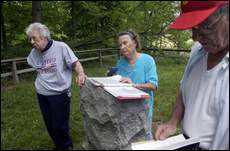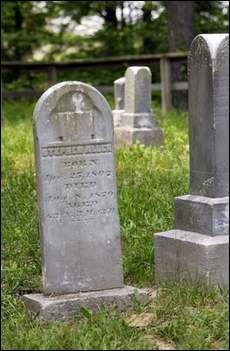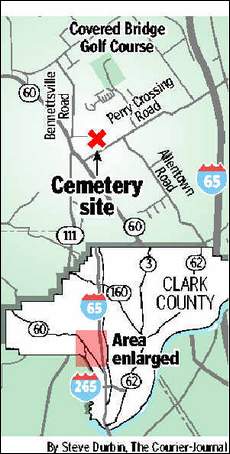More than 60 people packed last night's meeting of the Clark County Plan Commission, many with a common goal: stopping a proposed subdivision that would require moving graves that date to the 1870s.
Betty Johnson, 77, said her infant daughter was buried at the cemetery along Perry Crossing Road in 1947.
Standing under the shade of oak and walnut trees at the cemetery yesterday, Johnson said she was disturbed by a developer's proposal to move the graves and replace them with patio homes for the Autumn Ridge subdivision.
"That bothers me. Would you want them to dig your kids up?" she asked, resting her hand on a faded tombstone. Two proposals for Autumn Ridge were tabled last night until the Plan Commission's next meeting in June. Drawings filed with the county show one part of the two-part proposal on adjoining land parcels would create 41 lots on 14.7 acres. The other, which includes the cemetery, would have 46 lots on 9.3 acres.
Daniel Lenfert, one of the developers, said before the meeting that he wasn't familiar with state laws about relocating cemeteries.
"That's what attorneys are for," he said, adding that the move would be done legally.
According to Johnson's research, the Allen-Jenkins Cemetery has 31 graves, including three Civil War veterans and one veteran of the Spanish-American War.
Lenfert said he has arranged with Richard Pyke, a funeral director from Henryville, to move the remains.
Asked about the possibility of building around the cemetery, Lenfert said it doesn't fit the subdivision's design.
Johnson's husband, Daniel Johnson, is a member of the Clark County Cemetery Commission. Of the county's estimated 180 cemeteries, he said, he knows of just one -- with three graves -- that has been moved in the last eight years.
None, he said, have been moved since new a law protecting Indiana cemeteries took effect in 2002.
The law states that the spouse or parents of the deceased must give written consent before a grave can be moved. The Indiana Department of Natural Resources also must receive written notice, and relocation plans must be published in a local newspaper.
Questions also were raised about the first of the two Autumn Ridge sections after Plan Commission member David Ross Stevens told the group that earth had already been moved on the property, and a large pond drained, before the commission held its first meeting on the project.
Plan Commission President David Trotter said the timing of the earth-moving activity before the meeting appears to have violated county ordinances.
Paul Primavera, whose Corydon-based firm handled the engineering for Autumn Ridge, told Plan Commission members that he hadn't known any work had started and that he would take steps to deal with those concerns.
Primavera said it was the developers' first project and he could have better informed them about the process.
Residents from Perry Crossing Road also voiced concerns about what they consider small lot sizes; a planned connection to Sellersburg sewer lines; and an initial drawing that shows one road entrance for a total of 87 homes in the two projects.
Primavera said a double entrance is now planned, and other issues would be addressed in coming weeks.
Jeffersonville lawyer David Lewis, a former county commissioner and Plan Commission member, said some neighbors had hired him to challenge the project.
He said the site illustrates why the county should update its ordinances, or at least create a zoning designation called "rural residential" that would allow single-family homes, but only on large lots.
The commission also:
Gave preliminary approval to the proposed Oak Creek subdivision, with 178 lots on 90 acres off Ind. 3. Nine residents spoke against the project, raising concerns about traffic, wildlife and the rural character of the area north of Charlestown.
Agreed to table a request from Charlestown for planning and zoning control over an area called the "two-mile fringe" surrounding the city. A previous attempt at creating a fringe was ruled illegal in January by Clark Circuit Judge Daniel Donahue.
Some of the proposed area along Ind. 62 is now part of Charlestown but is scheduled to revert to the county at the end of this year as part of a settlement in a lawsuit over a February 2003 annexation.
Some members of the Plan Commission said they were leery about creating a fringe zoning area before the annexation had been resolved.
Concerns also were raised that the proposed fringe would pass through part of Jeffersonville's city limits. Charlestown city attorney Lonnie Cooper said another attempt at the fringe proposal will be made after those issues are resolved.
 From left, Mabel Balmer,
Betty Johnson and Dan Johnson all oppose plans by a developer to move
the Allen-Jenkins Cemetery to make room for patio homes in Clark
County. Betty Johnson said the cemetery contains 31 graves. (PHOTOS BY
ARZA BARNETT, THE COURIER-JOURNAL)
| ||
|
 Stephen Allen, who lived
from 1807 to 1870, was believed to be the first person buried in the
Allen-Jenkins Cemetery off Perry Crossing Road in Clark County. 
| ||
|
| ||
|